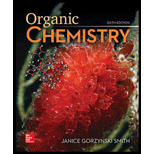
Concept explainers
(a)
Interpretation: The relation between given pair of compounds is to be determined.
Concept introduction: The stereogenic centers with
Enantiomer of a compound has opposite configuration at stereogenic centers. Diastereomers of a compound have at least one stereogenic centre with same configuration and at least one with opposite configuration.
(b)
Interpretation: Each compound is to be labeled as chiral or achiral.
Concept introduction: An atom containing four different atoms or groups, which produce stereoisomers on exchange of any two groups. These centers are known as stereogenic centers.
(c)
Interpretation: Among the given compounds, optically active compounds are to be determined.
Concept introduction: The phenomenon by which a chiral molecule is observed to rotate the plane polarized light in either a clockwise direction or anticlockwise direction is called as optical activity of the molecule.
(d)
Interpretation: Among the given compounds, compounds which have plane of symmetry are to be determined.
Concept introduction: An imaginary plane which bisects the molecule into halves such that these halves are mirror images of each other. This is known as plane of symmetry.
(e)
Interpretation: Among the given pair of compounds, boiling points is to be compared.
Concept introduction: Enantiomers are stereoisomers, which are non-superimposable images of each other. They have identical physical and chemical properties in symmetric environment. They rotate the plane-polarized light in equal amounts and in opposite directions.
Diastereomers of a compound have at least one stereogenic centre with same configuration and at least one with opposite configuration. Diastereomers of compound do not have mirror image relationship. They have different physical and chemical properties.
(g)
Interpretation: Equal mixtures of compounds C and D and compounds B and C is optically active or not is to be predicted.
Concept introduction: Enantiomers are stereoisomers, which are non-superimposable images of each other. They have identical physical and chemical properties in symmetric environment. They rotate the plane-polarized light in equal amounts and in opposite directions.
Diastereomers of a compound have at least one stereogenic centre with same configuration and at least one with opposite configuration. Diastereomers of compound do not have mirror image relationship. They have different physical and chemical properties.
Want to see the full answer?
Check out a sample textbook solution
Chapter 5 Solutions
ORGANIC CHEMISTRY (LOOSELEAF)
- 4. Read paragraph 4.15 from your textbook, use your calculated lattice energy values for CuO, CuCO3 and Cu(OH)2 an explain thermal decomposition reaction of malachite: Cu2CO3(OH)2 →2CuO + H2O + CO2 (3 points)arrow_forwardPlease sirrr soollveee these parts pleaseeee and thank youuuuuarrow_forwardIII O Organic Chemistry Using wedges and dashes in skeletal structures Draw a skeletal ("line") structure for each of the molecules below. Be sure your structures show the important difference between the molecules. key O O O O O CHON Cl jiii iiiiiiii You can drag the slider to rotate the molecules. Explanation Check Click and drag to start drawing a structure. Q Search X G ©2025 McGraw Hill LLC. All Rights Reserved. Terms of Use F 3 W C 3/5arrow_forward
- 3. Use Kapustinskii's equation and data from Table 4.10 in your textbook to calculate lattice energies of Cu(OH)2 and CuCO3 (4 points)arrow_forward2. Copper (II) oxide crystalizes in monoclinic unit cell (included below; blue spheres 2+ represent Cu²+, red - O²-). Use Kapustinski's equation (4.5) to calculate lattice energy for CuO. You will need some data from Resource section of your textbook (p.901). (4 points) CuOarrow_forwardWhat is the IUPAC name of the following compound? OH (2S, 4R)-4-chloropentan-2-ol O (2R, 4R)-4-chloropentan-2-ol O (2R, 4S)-4-chloropentan-2-ol O(2S, 4S)-4-chloropentan-2-olarrow_forward
- Use the reaction coordinate diagram to answer the below questions. Type your answers into the answer box for each question. (Watch your spelling) Energy A B C D Reaction coordinate E A) Is the reaction step going from D to F endothermic or exothermic? A F G B) Does point D represent a reactant, product, intermediate or transition state? A/ C) Which step (step 1 or step 2) is the rate determining step? Aarrow_forward1. Using radii from Resource section 1 (p.901) and Born-Lande equation, calculate the lattice energy for PbS, which crystallizes in the NaCl structure. Then, use the Born-Haber cycle to obtain the value of lattice energy for PbS. You will need the following data following data: AH Pb(g) = 196 kJ/mol; AHƒ PbS = −98 kJ/mol; electron affinities for S(g)→S¯(g) is -201 kJ/mol; S¯(g) (g) is 640kJ/mol. Ionization energies for Pb are listed in Resource section 2, p.903. Remember that enthalpies of formation are calculated beginning with the elements in their standard states (S8 for sulfur). The formation of S2, AHF: S2 (g) = 535 kJ/mol. Compare the two values, and explain the difference. (8 points)arrow_forwardIn the answer box, type the number of maximum stereoisomers possible for the following compound. A H H COH OH = H C Br H.C OH CHarrow_forward
 Organic ChemistryChemistryISBN:9781305580350Author:William H. Brown, Brent L. Iverson, Eric Anslyn, Christopher S. FootePublisher:Cengage Learning
Organic ChemistryChemistryISBN:9781305580350Author:William H. Brown, Brent L. Iverson, Eric Anslyn, Christopher S. FootePublisher:Cengage Learning Organic Chemistry: A Guided InquiryChemistryISBN:9780618974122Author:Andrei StraumanisPublisher:Cengage Learning
Organic Chemistry: A Guided InquiryChemistryISBN:9780618974122Author:Andrei StraumanisPublisher:Cengage Learning

